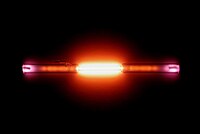
Photo from wikipedia
Background: Argon plasma coagulation (APC) is a tool used in the management of tracheobronchial obstruction or bleeding. Complications include gas embolism which can cause devastating effects including hemodynamic instability, cardiac… Click to show full abstract
Background: Argon plasma coagulation (APC) is a tool used in the management of tracheobronchial obstruction or bleeding. Complications include gas embolism which can cause devastating effects including hemodynamic instability, cardiac arrest, and stroke. Multiple theories as to how gas embolism occurs with APC have been postulated; however, none have identified the exact mechanism. Objectives: To identify the mechanism by which APC causes gas embolism in the tracheobronchial tree. Methods: Using an explanted porcine tracheobronchial tree with lung parenchyma, the APC catheter was applied through noncontact and direct contact to the endobronchial airway mucosa via flexible bronchoscopy. This was done at multiple gas flow settings and pulse durations. Visual changes in the mucosa were photographed, videoed, and described. Results: Gross evidence of submucosal gas transfer occurred when the APC catheter was in direct contact with the mucosa at all gas flow settings in all applications, despite using shorter pulse durations. Whenever the catheter was not in contact with the mucosa, there was no transfer of gas at any gas flow setting or pulse duration. Conclusions: Direct mucosal contact with the APC probe leads to submucosal gas deposition and is a likely mechanism for gas entry into the intravascular space. In reported cases of APC-associated gas embolism, presence of a vascularized endobronchial tumor may have increased the risk of gas tracking into the intravascular space. Care should be taken when applying APC during brisk bleeding or limited vision, as inadvertent mucosal contact may occur and could increase the risk of gas embolism.
Journal Title: Respiration
Year Published: 2021
Link to full text (if available)
Share on Social Media: Sign Up to like & get
recommendations!